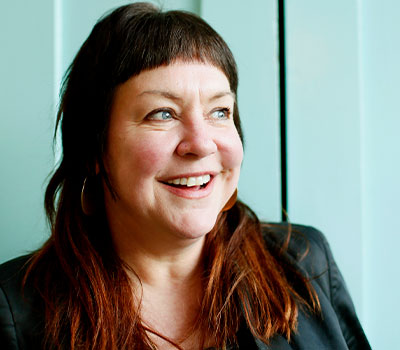Jen O’Neil is the Beverage Director of Sea Creatures restaurant group, which opened The Walrus and the Carpenter in Seattle’s Ballard neighborhood in 2010. (The group also includes The Whale Wins, Lioness and Bateau). O’Neil got into wine 25 years ago. “I am 52 years old. I’m no spring chicken,” she says, recalling how she became intrigued by the geography of wine while working as a server at Tom Douglas’s Dahlia Lounge. She left to work in retail, at Pike & Western, then partnered in a small import company, bringing in wines from Jura and Alto Piemonte. Now, back in restaurants, she landed at chef Renee Erickson’s group, where The Walrus and the Carpenter has just been nominated for a James Beard Award for Outstanding Restaurant. O’Neil describes the 40-seat restaurant as having an electric atmosphere—they open at 4 PM and most days there is a line out the door. O’Neil says the food and wine, which includes up to eight selections of local oysters, is like “Normandy meets the Pacific Northwest.” —Alissa Bica


Do you have any personal favorite wine regions?
Oh, yeah. Friuli, Burgundy and Austria. Not only do I find those three regions super interesting, but I always want wines from those areas. It’ll never be like, I’m not in the mood for that. I’m always in the mood for wines from those areas.
We just opened an Italian wine bar called Lioness about two weeks ago. So, I get to put all my Italian chops over there. I really like the wines from Venica & Venica. They just started a new line called Via Apina. The Venica wines wholesale can be in the mid 20s and up so, they started a line that we can do as glass pours. I have a Via Alpina Sauvignon Blanc right now. It’s really great to be able to have Friulian wines by-the-glass. I love high altitude Alpine whites in general. Sauvignon blanc has been in Friuli for so long and they have their own expression. I like Friulian sauvignon blancs more than Sancerre. I know that’s blasphemy.
At The Walrus and the Carpenter, I’m really digging this producer from the Mâcon, Smith-Chapel. Their aligoté is one of the most beautiful wines I’ve had in a long time. It makes me realize how much I love tactile wines and the mouthfeel of wines as much as I like the aromatics. And that can be a big factor in what I choose for the restaurants as well. It’s super electric. It’s chalky. It has the slightest amount of perfume but barely noticeable. It’s a really beautiful wine.
I have to have a Sancerre on the list or else there would be a mutiny. But the team is very comfortable talking about wine so I can put stuff on the list like roussannes and aligotés. One of my favorite wines on the list right now is Albert Boxler Edelzwicker. And F.X. Pichler Grüner Veltliner. I do try to have a kind of a smattering of more familiar wines, and then the other half will be ‘hey, let’s get adventurous people wines.’
At The Walrus, we also always have to have a Muscadet or mutiny, again. Lots of mutinies. I always have Muscadet by-the-glass and right now we have Pépière, who is the master of Muscadet. Then, to have a fun version, I always try to have a Cru Communal—I want people to start exploring something with a little bit of age on it. I also have a sparkling Muscadet from Jérémie Huchet.
What other wine categories to you focus on at The Walrus and the Carpenter?
Wines that have a lot of bold acidity—probably the most important thing. And we have way more white wine than red wine. So, whites with a saline quality to them. Whites with bold acidity. And again, like I was saying earlier, I’m a texture gal; I want the wine to have a lot of texture. Our white wines have hardly any perceptible oak flavor—the only wine that you can get a little bit of oaky notes would be a white Burgundy. [Our menu is a lot of fish] and I think oakiness or tannin can get in the way of our foods. One of our best-selling white wines right now is Granbazán Albariño. It’s the only Spanish wine on the list and it’s selling like gangbusters. It has a gorgeous mouthfeel to it, and the minute you think it’s going to start to get a little too rich and oily, you get that saline.
Sticking with the old Normandy thing, I definitely lean French, for sure. The list is about 70 percent French. But then I’ve been doing this little experiment lately; I’ve been putting a lot of Pacific Northwest wines on the red wine list. I tend to like Pacific Northwest reds a little bit more than the whites. There’s been a really great movement of producers that are not using a lot of oak. They’re not high-alcohol wines. There are a lot of producers making carbonic wines in Washington and Oregon. So, I’ve been having a lot of fun putting some tiny producers that I like on the list. Right now, we have a winery from a young couple in the Tualatin Hills, which is Oregon’s newest AVA, called Fossil & Fawn. They’re making wines naturally, but they’re very clean. They purchased an old-for-Oregon vineyard from the ’70s called No Clos Radio. One of the wines I have from them, called Beautiful Grandpa Pinot Noir, is from those really old vines. I’m really happy to have that. And that’s been selling really well.
Is there a category you wish you could sell more of?
German wine. Alsace will move, but I always put on a super steely, minerally, dry German riesling, and they just don’t move. Maybe they think it’s going to be sweet, or maybe they think this is a French-style Pacific Northwest restaurant, why do I want German wine? But then that argument doesn’t even work for my theory because we sell a ton of albariño. When I went in for dinner not too long ago, I was drinking riesling all night. Everyone else was drinking Muscadet. I was drinking this riesling because I’m like ‘Well, nobody else is gonna buy it.’
What other trends have you noticed?
I’m noticing a lot of non-alcoholic drinkers. I don’t think it’s just Dry January. I think that it’s gotten into people’s feeds, or it’s just gotten out there that alcohol is not good for you or something. I’ve gotten stuff on my feed about only having one drink a day and alcohol not being good for you. I’m wondering if that’s scaring people away a little bit from drinking. So, we have upped our non-alcoholic offering in all of our programs. There are such great NA spirits so, all of our restaurants now have at least two NA offerings. That has been a trend that I’ve noticed. This time last year, people were drinking a lot of spirits. People would come in and have their high-alcohol cocktail, then they’d have a glass or two of wine, but now that is almost being replaced with NA’s.
Based in Los Angeles, California, Alissa Bica is the Associate Editor and Spirits Critic at Wine & Spirits. She is also a sommelier at 71 Above and co-runs the home wine tasting company, Côte Brune and Blonde. In any rare moments of free time, she writes about obscure grape varieties in the blog Off the Beaten Wine Path.
This is a W&S web exclusive. Get access to all of our feature stories by signing up today.




















